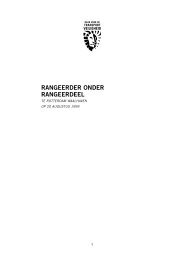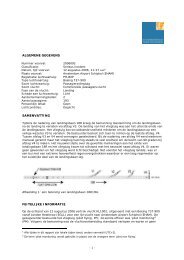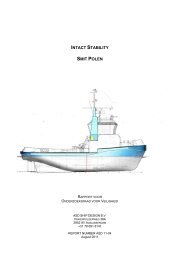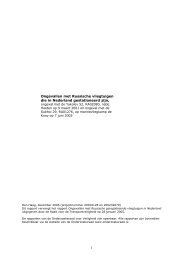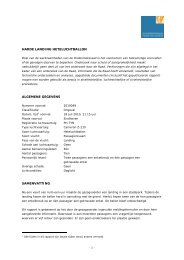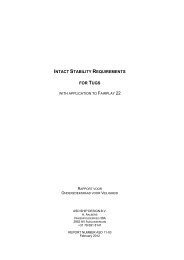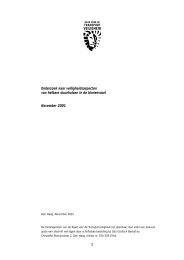Rejected takeoff after the takeoff decision speed 'V ', Boeing B737 ...
Rejected takeoff after the takeoff decision speed 'V ', Boeing B737 ...
Rejected takeoff after the takeoff decision speed 'V ', Boeing B737 ...
Create successful ePaper yourself
Turn your PDF publications into a flip-book with our unique Google optimized e-Paper software.
2.5 PERSONAL INFORMATION<br />
The captain, at <strong>the</strong> time of <strong>the</strong> event, had 3628 hours total flying experience with 2061 flying hours<br />
on type (<strong>B737</strong>). The captains last proficiency check, line check and Cockpit Resource Management<br />
(CRM) training all occurred in <strong>the</strong> period February to March 2010.<br />
The first officer, at <strong>the</strong> time of <strong>the</strong> event, had 2300 hours total flying experience and 1170 hours on<br />
type (<strong>B737</strong>). The first officers last proficiency check, line check and Cockpit Resource Management<br />
(CRM) training all occurred in <strong>the</strong> period January to March 2010.<br />
On <strong>the</strong> morning of <strong>the</strong> event flight both crew members reported for duty at <strong>the</strong> Faro base station.<br />
Flight crew history show that both crew members met <strong>the</strong> rules and standards of flight crew duty<br />
and rest times.<br />
2.6 AIRCRAFT INFORMATION<br />
The records provided show that <strong>the</strong> aircraft had a valid certificate of airworthiness and no<br />
outstanding maintenance actions were present. According to <strong>the</strong> weight and balance information<br />
of <strong>the</strong> event flight <strong>the</strong> aircraft was loaded within aircraft weight limits. The weight distribution and<br />
loading of <strong>the</strong> aircraft kept <strong>the</strong> centre of gravity within specified limits.<br />
2.7 METEOROLOGICAL INFORMATION<br />
The wea<strong>the</strong>r conditions reported to <strong>the</strong> crew by air traffic control were a wind <strong>speed</strong> of 5 knots<br />
with gusts to 10 knots. The wind came from <strong>the</strong> north east (magnetic heading 30 degrees). The<br />
temperature was 19 degrees Celsius and <strong>the</strong> dew point was 9 degrees Celsius. The reported<br />
pressure was 1021 hectopascal.<br />
2.8 AERODROME INFORMATION<br />
Eindhoven Airport is a joint civil and military airport with a single runway. The magnetic heading<br />
of <strong>the</strong> runway is 40 degrees and 220 degrees (04/22). The <strong>takeoff</strong> run available (TORA) is 3000<br />
metres. The runway friction coefficient or average braking coefficient was measured during <strong>the</strong> day<br />
of <strong>the</strong> event. The friction coefficient was determined to be 0.81 which makes braking conditions<br />
‘good’.<br />
2.9 FLIGHT RECORDER<br />
After <strong>the</strong> event <strong>the</strong> data from <strong>the</strong> flight data recorder (FDR) was provided to <strong>the</strong> Dutch Safety<br />
Board for use in <strong>the</strong> investigation. The data was analyzed using conversion factors provided by<br />
<strong>the</strong> aircraft manufacturer. In appendix C a plot of various parameters recorded on <strong>the</strong> flight data<br />
recorder is presented. The cockpit voice recorder (CVR) was not available for <strong>the</strong> investigation.<br />
Analysis of <strong>the</strong> flight data showed that at 09.35 hours movement of <strong>the</strong> aircraft was recorded<br />
and <strong>the</strong> aircraft changed heading and gained ground<strong>speed</strong>. At this time <strong>the</strong> aircraft was steered<br />
towards <strong>the</strong> runway. At 09.40 hours a control check was performed, all <strong>the</strong> flight controls in <strong>the</strong><br />
cockpit and <strong>the</strong> associated control surfaces on <strong>the</strong> aircraft moved to <strong>the</strong> full deflection positions.<br />
The flight data showed that <strong>the</strong> aircraft lined up on <strong>the</strong> runway at 09.45:08 hours. Engine power<br />
was applied and 46 seconds later and <strong>the</strong> aircraft started to roll down <strong>the</strong> runway. Between 0 and<br />
50 knots, changes in magnetic heading were recorded. The changes in heading were counteracted<br />
by rudder (pedal) inputs and at around 60 knots <strong>the</strong> aircraft heading became stable and in <strong>the</strong><br />
direction of <strong>the</strong> runway.<br />
11




